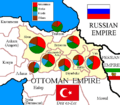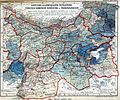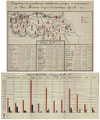Armenians in the Ottoman Empire facts for kids
The Ottoman rule of Armenia describes a long period when the land of Armenia was part of the Ottoman Empire. This began when Mehmed II took power, but Armenia became a full part of the empire during the rule of Selim II (1524–1574). This period lasted for about 300 years.
After the Russo–Turkish War (1828–1829), the eastern part of Armenia, known as Eastern Armenia, became part of the Russian Empire. However, Western Armenia stayed under Ottoman rule. This continued until the Ottoman Empire ended after World War I.
A very sad event happened on April 24, 1915. Many Armenian leaders were arrested by Ottoman officials. Later, a law called the Tehcir Law (May 29, 1915) led to a large number of Armenians living in Anatolia dying. This terrible event is known as the Armenian Genocide.
Contents
Armenians Under Ottoman Rule
For centuries, Armenians lived in lands that became part of the Ottoman Empire. They were an important part of the empire's diverse population. Armenians were known for their skills in trade, crafts, and business.
Life in the Empire
Armenians, like other non-Muslim groups, were often allowed to practice their own religion. They had their own churches and communities. Leaders within the Armenian community, sometimes called "beys," helped manage their people's affairs.
The Ottoman Empire had a system where different groups lived side-by-side. This meant Armenians kept much of their culture and traditions. Many Armenians lived in specific regions, especially in what was known as Western Armenia.
Changes Over Time
Over the years, the relationship between Armenians and the Ottoman government changed. As the 19th century ended and the 20th century began, there were growing tensions. Different groups within the empire sought more rights or independence.
The maps from this period show where Armenian communities were located. They highlight the areas with many Armenian residents. These maps are important for understanding the history of the region.
World War I and Its Impact
When World War I started, the Ottoman Empire joined the war. This period brought huge changes and difficulties for many people. Sadly, it led to the tragic events of 1915.
The war created a very unstable time. Many Armenians were forced to leave their homes. A large number of them died during these forced movements. This dark chapter in history had a lasting impact on the Armenian people.
Images for kids
-
Ethnic map of six Armenian Vilayets in the Ottoman Empire according to available information.
-
An "Armenian bey", the executive authority on Armenian reaya. The bey was part of civil administration.
-
Costumes of the Ottoman Empire extending to Muslims, Christians, Jewish communities, clergy, tradesmen, state and military officials were strictly regulated during the reign of Süleyman the Magnificent.
-
Calouste Gulbenkian, internationally known businessman and philanthropist born in 1869 at Üsküdar
-
6 Armenian provinces of Western Armenia. Patten, William and J.E. Homas, Turkey in Asia, 1903.
-
Karekin Pastermadjian member of "Chamber of Deputies" representative of the Armenian Revolutionary Federation from Erzurum. He was later elected to be ambassador of the Armenia to the United States.
-
Six Armenian provinces of Western Armenia and boundaries between countries before World War I
See also
 In Spanish: Armenios en el Imperio otomano para niños
In Spanish: Armenios en el Imperio otomano para niños















